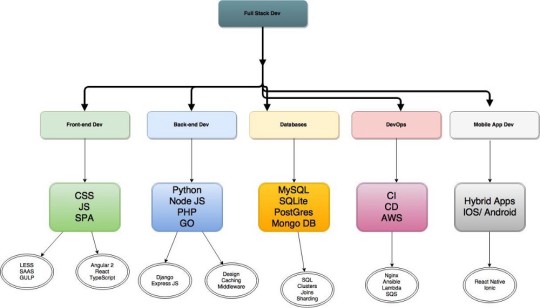#hire best performing sap abap consultant
Explore tagged Tumblr posts
Text
How can I handle and manage dependencies in this project efficiently?

In the ever-evolving landscape of software development, the ability to manage dependencies efficiently is crucial for the success of any project. Dependencies refer to external libraries, frameworks, or modules that a project relies on to function properly. As a developer at Coders Brain Technology, understanding how to handle these dependencies effectively is essential to streamline development, enhance productivity, and deliver high-quality software solutions. This article will explore various strategies and tools to manage dependencies efficiently in your projects.
Clearly Define Project Requirements
Before diving into managing dependencies, it is essential to have a clear understanding of the project's requirements. Define the scope and objectives precisely to identify which dependencies are necessary for the project. Avoid including unnecessary dependencies, as they can lead to bloated codebases and potential conflicts in the future. By having a well-defined set of requirements, you can focus on selecting the most suitable and relevant dependencies for your project.
To know more about : -
Use Package Managers
Package managers are invaluable tools for handling dependencies efficiently. They simplify the process of installing, updating, and removing external libraries or modules in your project. NPM (Node Package Manager) for JavaScript, pip for Python, and Maven for Java are popular examples of package managers that save developers from the tedious task of manually managing dependencies. Utilizing these tools not only ensures that the correct versions of dependencies are used but also makes collaboration with other team members seamless.
Version Control
Maintaining proper version control is fundamental in dependency management. Different versions of dependencies might introduce new features, bug fixes, or security updates. By employing version control systems like Git, you can keep track of changes in your codebase and quickly roll back to previous states if needed. Moreover, version control allows multiple developers to work on the same project simultaneously without worrying about dependency conflicts.
Regularly Update Dependencies
Outdated dependencies can pose significant security risks and may hinder the adoption of the latest features and improvements. Stay vigilant about updating your project's dependencies regularly. Keep track of releases and changelogs for your dependencies, and test updates in isolated environments to avoid potential compatibility issues. Frequent updates ensure that your project remains secure, stable, and benefits from the latest advancements.
Understand Dependency Interactions
As your project grows, managing dependencies can become complex, especially when certain dependencies rely on others. It is vital to comprehend these interactions to avoid conflicts and ensure smooth functioning. Utilize tools like dependency graphs to visualize how different modules relate to each other. Understanding these relationships helps you plan for updates or changes with minimal disruptions to the project.
Minimize Dependencies when Possible
While dependencies are crucial for efficient development, it's equally important to strike a balance and avoid unnecessary dependencies. The more dependencies a project has, the greater the risk of compatibility issues, increased load times, and potential security vulnerabilities. Assess whether a particular functionality truly requires an external dependency, or if it can be implemented using native language features or existing project resources.
Automated Testing
Implementing automated testing is a key strategy in managing dependencies efficiently. Automated tests, such as unit tests and integration tests, ensure that changes to dependencies or your codebase do not break existing functionality. Continuous Integration (CI) tools can automate the testing process, running tests whenever changes are made to the codebase or dependencies, providing prompt feedback to the development team.
Documentation
Maintaining comprehensive documentation for your project and its dependencies is essential for efficient management. Document each dependency's purpose, version, and any special configurations or considerations. Proper documentation allows new team members to understand the project's structure and dependencies quickly and helps troubleshoot potential issues in the future.
Conclusion
Effectively handling and managing dependencies in your project is critical for successful software development. By clearly defining project requirements, using package managers, employing version control, and understanding dependency interactions, you can ensure a streamlined development process. Additionally, regularly updating dependencies, minimizing dependencies when possible, implementing automated testing, and maintaining thorough documentation all contribute to efficient dependency management.
As a developer at Coders Brain Technology, mastering these dependency management strategies will enhance productivity, foster collaboration, and empower you to deliver robust, high-quality software solutions that stand the test of time. Embrace these best practices, and you will be well-prepared to tackle any future projects with confidence. Happy coding!
Read more : -
1 note
·
View note
Text
Which Is the Best SAP Training Institute in Pune?
If you consider advancing your career with SAP certification, Pune offers excellent learning opportunities. SAP, or Systems Applications and Products, is widely used by companies worldwide for enterprise resource planning (ERP). With organizations increasingly relying on SAP to streamline operations, having SAP skills can make you a highly sought-after professional. Let's explore why Pune is an excellent place to start your SAP journey, the modules covered in SAP training, companies that hire SAP professionals, and how much you can earn with SAP expertise.
Why Choose an SAP Training Institute in Pune?
Pune is a hub for technology and education, making it an ideal location to pursue SAP course in Pune. Reputed institutes in the city provide comprehensive programs tailored to meet the needs of both beginners and professionals. These institutes focus on real-world scenarios and practical knowledge, ensuring you are job-ready.
Key benefits of training in Pune include:
Experienced faculty with industry expertise.
Access to real-time projects and case studies.
Strong placement assistance with top companies.
Modules Covered in an SAP Course in Pune
SAP offers a range of modules catering to various business needs. Here’s a breakdown of the major modules you can learn:
SAP FICO (Financial Accounting and Controlling):
Focuses on managing financial transactions and data analysis.
Includes ledger management, financial reporting, and cost center accounting.
SAP MM (Material Management):
Deals with procurement and inventory management.
Covers vendor evaluation, stock management, and material planning.
SAP HR (Human Resources):
Streamlines employee management processes.
Encompasses payroll management, recruitment, and performance evaluation.
SAP SD (Sales and Distribution):
Handles order management, pricing, and billing.
Covers customer master data and delivery processing.
SAP PP (Production Planning):
Focuses on manufacturing processes and production planning.
Includes capacity planning and material requirement planning.
SAP QM (Quality Management):
Ensures quality standards in processes and products.
Covers inspection planning, quality control, and audits.
SAP SuccessFactors:
A cloud-based HR management solution.
Specializes in talent management, learning, and workforce analytics.
Companies Hiring SAP Professionals
Pune is home to a diverse range of companies that rely on SAP solutions for their operations. Here are some prominent employers for SAP-certified professionals:
Infosys: A global leader in IT services and consulting.
Tata Consultancy Services (TCS): Known for its large-scale ERP implementations.
Wipro: Specializes in SAP-based enterprise solutions.
Capgemini: Offers consulting and SAP implementation services.
Accenture: A major recruiter for SAP consultants and analysts.
Additionally, HR professionals with SAP skills are in demand across industries such as manufacturing, retail, and pharmaceuticals.
Salary Structure for SAP Professionals
SAP-certified professionals enjoy competitive salaries due to their specialized skills. Here's a general idea of the earning potential:
Entry-level positions: ₹4–6 LPA (Lakhs Per Annum).
Mid-level roles: ₹7–15 LPA.
Experienced professionals: ₹15–25 LPA or more.
HR professionals with SAP expertise in modules like SuccessFactors or SAP HR can earn even higher salaries, especially in leadership roles.
Skills Needed for SAP Careers
To excel in an SAP-related career, focus on these skills:
Analytical Thinking: Ability to interpret and manage large data sets.
Business Acumen: Understanding business processes and ERP systems.
Problem-Solving: Identifying and resolving issues in SAP systems.
Technical Knowledge: Familiarity with SAP tools and programming (ABAP, HANA).
Additionally, strong communication skills and project management abilities are advantageous for client-facing roles.
Recommended SAP Institutes in Pune
Finding the right training institute is crucial for a successful career in SAP. Here’s a list of some top SAP institutes in Pune:
Connecting Dots ERP:
Offers a wide range of SAP courses.
Known for experienced trainers and excellent placement support.
Locations in Pune and Mumbai make it a flexible option for learners.
Seed Infotech:
Provides industry-oriented training with live project experience.
Offers customized courses based on market needs.
Atos India:
Known for its certified SAP programs.
Offers advanced modules and placement assistance.
Authorized SAP Education Partners:
Collaborate directly with SAP to provide genuine certifications.
Focus on hands-on training and updated course material.
When choosing an SAP Training Institute in Pune, consider factors like course content, faculty expertise, and placement record.
Tips for SAP Success
Choose the Right Module: Select a module that aligns with your career goals and interests. For HR professionals, SAP HR or SuccessFactors are ideal.
Practice Regularly: Use SAP practice servers to enhance your hands-on skills.
Certify Yourself: An official SAP certification adds credibility to your resume.
Stay Updated: SAP technology evolves constantly; keep learning to stay relevant.
Final Thoughts
SAP skills are a gateway to lucrative career opportunities across industries. By enrolling in a reputed SAP Training Institute in Pune, you can gain the knowledge and expertise needed to succeed in this competitive field. Whether you're aiming for a career in HR, finance, or logistics, SAP certification can set you apart.
Start your journey today by choosing the best SAP course in Pune, and make your mark in the world of enterprise solutions!
0 notes
Text
SAP HR Table For Employee Master

SAP HR Tables: The Backbone of Employee Master Data
The SAP Human Resources (SAP HR) module, also known as SAP Human Capital Management (HCM), is a powerful tool for managing all facets of an organization’s workforce. At its heart lies a complex network of tables designed to store all relevant employee master data. Understanding these tables is crucial for anyone working within SAP HR, including consultants, system administrators, and HR professionals.
Key SAP HR Tables
While a comprehensive list of HR tables would be extensive, let’s focus on the core tables containing the most critical employee master data:
PA0000 (Actions): Records all personnel actions that affect an employee’s status, such as hiring, promotions, transfers, or terminations.
PA0001 (Organizational Assignment): Stores an employee’s organizational information, including their position, department, cost center, and job title.
PA0002 (Personal Data): This section houses key personal details of an employee, such as name, address, date of birth, nationality, and marital status.
PA0006 (Addresses): Contains multiple address types (home, work, etc.) for employees.
PA0008 (Basic Pay): Information about employee salary components.
PA0009 (Bank Details): Stores an employee’s bank account information for salary and payment processing.
Relationships Between Tables
The true power of SAP’s system lies in the relationships between these tables. The critical field connecting most HR tables is the Personnel Number (PERNR). This unique identifier is a central reference point throughout the SAP HR system.
Accessing HR Tables
There are several ways to access SAP HR Tables:
Transaction Codes: SAP provides transaction codes for working with specific data sets. Some common ones include:
PA20: Display HR Master Data
PA30: Maintain HR Master Data
SAP Table Browser (SE16/SE16N): This tool lets you view table contents directly and is excellent for quick data checks.
ABAP Programming: For more complex data manipulation and reporting, ABAP programming provides the ultimate flexibility for interacting with HR tables.
Important Considerations
Data Sensitivity: Employee master data is susceptible. Ensure you have the proper authorizations before accessing SAP HR tables.
Data Consistency: It is critical to maintain data integrity across these tables. Changes in one table may need to be reflected in others to avoid discrepancies.
Customization: Organizations may have customized HR tables or create their own to suit specific business needs. Understanding these customizations is essential for effective HR data management.
In Conclusion
Mastering the core SAP HR tables is essential for effectively managing employee data within the SAP HCM system. By understanding their structure and relationships and how to access them, you’ll be well-equipped to perform HR tasks, generate reports, and ensure the accuracy of your organization’s critical employee information.
youtube
You can find more information about SAP HR in this SAP HR Link
Conclusion:
Unogeeks is the No.1 IT Training Institute for SAP HR Training. Anyone Disagree? Please drop in a comment
You can check out our other latest blogs on SAP HR here – SAP HR Blogs
You can check out our Best In Class SAP HR Details here – SAP HR Training
———————————-
For Training inquiries:
Call/Whatsapp: +91 73960 33555
Mail us at: [email protected]
Our Website ➜ https://unogeeks.com
Follow us:
Instagram: https://www.instagram.com/unogeeks
Facebook: https://www.facebook.com/UnogeeksSoftwareTrainingInstitute
Twitter: https://twitter.com/unogeeks
0 notes
Text
Jobs SAP HR

Unlocking the Power of SAP HR: Your Guide to a Rewarding CareerSAP is a global leader in enterprise software, and its Human Resources (HR) module, known as SAP SuccessFactors HCM (Human Capital Management), is widely used by companies across the globe. A career in SAP HR offers exciting opportunities for professionals passionate about technology and transforming how organizations manage their people.What is SAP HR?SAP HR, also referred to as SAP SuccessFactors, is a comprehensive cloud-based HR management suite. It provides tools to streamline and automate core HR processes, including:
Recruitment and Talent Acquisition: Attract, screen, hire, and onboard the right talent.
Payroll and Time Management: Ensure accurate and timely payroll processing and manage complex attendance and leave policies.
Learning and Development: Drive employee growth through personalized training and development programs.
Performance Management: Set clear goals, provide feedback, and evaluate employee performance.
Analytics and Reporting: Gain valuable insights into your workforce to make data-driven decisions.
Why Choose a Career in SAP HR?
High Demand: As companies increasingly adopt digital HR solutions, skilled SAP HR professionals are in high demand across industries in India and internationally.
Excellent Growth Potential: SAP HR career paths offer diverse roles, from functional consultants to technical developers, with opportunities for advancement.
Competitive Salaries: SAP HR professionals command competitive compensation packages.
Impactful Work: Shape the HR function of organizations and directly impact employee experience.
Types of SAP HR Jobs
SAP HR Functional Consultant: Designs and configures the SAP HR system to meet an organization’s specific needs. Requires a strong understanding of HR processes and best practices.
SAP HR Technical Consultant: This position focuses on the coding, development, and technical aspects of the SAP HR system. Programming knowledge (ABAP) is often necessary.
SAP HR Project Manager: This position manages the implementation of SAP HR projects, ensuring they are completed on time and within budget.
SAP HR Support Specialist: Provides ongoing technical and functional support to users of the SAP HR system.
SAP HR Trainer: Develops and delivers training programs to educate users on leveraging the SAP HR system.
How to Get Started in SAP HR
Educational Background: A bachelor’s degree in Business, Computer Science, Human Resources, or a related field is preferred.
Gain SAP Certification: To demonstrate your knowledge and skills, consider getting certified in SAP SuccessFactors. SAP offers certifications in various HR modules (check their official website for the latest information).
Build Experience: Take up internships or entry-level roles to gain hands-on experience with SAP HR.
Network: Connect with SAP HR professionals through online communities and industry events.
Job Search Resources (India Focus)
SAP Careers:
LinkedIn: Search using keywords such as “SAP HR,” “SAP SuccessFactors,” and “SAP HCM.”
Popular Job Portals:
Naukri.com
Indeed
Monster India
The Future of SAP HRSAP HR continues to evolve, focusing on artificial intelligence, machine learning, and employee experience. Staying abreast of these trends will enhance your opportunities in this exciting field.
youtube
You can find more information about SAP HR in this SAP HR Link
Conclusion:
Unogeeks is the No.1 IT Training Institute for SAP HR Training. Anyone Disagree? Please drop in a comment
You can check out our other latest blogs on SAP HR here – SAP HR Blogs
You can check out our Best In Class SAP HR Details here – SAP HR Training
———————————-
For Training inquiries:
Call/Whatsapp: +91 73960 33555
Mail us at: [email protected]
Our Website ➜ https://unogeeks.com
Follow us:
Instagram: https://www.instagram.com/unogeeks
Facebook: https://www.facebook.com/UnogeeksSoftwareTrainingInstitute
Twitter: https://twitter.com/unogeeks
0 notes
Photo

Top MNC Companies are Hiring. Get the Right Job for Your Career. Find Better with itconsultant4u.com
Are you professional in SAP ABAP? Then what are you waiting for here is an opportunity to work with Fujitsu
Job Designation: SAP ABAP Application Developer
Company: Fujitsu
Skills: SAP S/4 HANA, SPPD /SPAU, SAP ECC 5.0 / 6.0 and SAP BAPI/RFC
Experience Range: Mid Level Experience
Location: Pune
Educational Requirements: Graduation from Reputed university or Technical or Management degree or equivalent education
Job Description:
Working Experience on S/4 HANA / S/4 HANA certified will be added advantage.
Worked on SAP S/4 HANA Migration Project or S/4 HANA implementation project, Code remediation i.e. SPPD /SPAU activity
Experience with medium/large scale implementation of SAP ECC 5.0 / 6.0.
An absolute understanding of mapping technical designs to Functional Documents (FS) & creating/reviewing corresponding Technical Specs(TS).
Detailed & exhaustive understanding of coding practices & naming conventions in ABAP.
Data Dictionary Concepts (Mandatory)
Classical / Interactive / ALV (Mandatory)
SAP Script / Smart forms /Adobe Forms (Mandatory)
Module Pool (Mandatory)
SAP BAPI/RFC as well as update tasks FM (Mandatory)
Performance optimizations (Mandatory)
ABAP enhancements (Mandatory)
Proficient in finding correct User Exit / SAP Enhancements Points and SAP BADI. (Mandatory)
IDOC Configuration, extensions, custom IDOC (Mandatory as working knowledge, if not complete hands-on)
Interface development
Development Experience in SAP Modules(MM, SD, FI, PP, etc.,) Excellent client-facing consulting skills (mandatory)
Excellent analytical skills and debugging skills (mandatory)
Should be well versed with SAP standards and best practices.
Experience with OSS Note application & validation.
JLPT N2/N3 preferred.
Apply Now Here: http://bit.ly/sap-abap-developer
#sap abap developer#sap jobs#pune jobs#itconsultant4u#job search#it consulting#it consultancy#it jobs#it career#job seek
1 note
·
View note
Text
How do you ensure the security of the applications or systems you develop?

In today's rapidly evolving digital landscape, the security of applications and systems has become a paramount concern for IT companies in Dwarka and beyond. With cyber threats constantly on the rise, ensuring robust security measures is not just an option but a necessity to protect sensitive data, maintain customer trust, and safeguard business reputation. This article provides a comprehensive guide for IT companies in Dwarka to enhance the security of the applications and systems they develop, thus fortifying their digital infrastructure against potential breaches.
To know more about : -
Understanding the Threat Landscape
Before diving into the security measures, it is crucial for IT companies in Dwarka to comprehend the prevailing threat landscape. Cybersecurity threats come in various forms, such as:
Malware and Viruses: Malicious software that can infiltrate systems, steal data, or cause damage.
Phishing Attacks: Social engineering tactics to trick users into revealing sensitive information.
Data Breaches: Unauthorized access or disclosure of sensitive data, leading to severe consequences.
SQL Injection: Exploiting vulnerabilities in web applications to manipulate databases.
DDoS Attacks: Overwhelming servers with traffic, causing applications and systems to become unavailable.
Best Practices for Ensuring Application and System Security
1. Conduct Thorough Security Testing
Before deploying any application or system, rigorous security testing must be performed. Various testing methodologies like penetration testing, vulnerability assessments, and code reviews help identify potential weaknesses in the software. Addressing these issues proactively can significantly reduce the risk of exploitation.
2. Implement Multi-factor Authentication (MFA)
MFA adds an extra layer of protection by requiring users to provide multiple forms of identification before granting access. Utilizing methods such as SMS codes, biometrics, or hardware tokens makes unauthorized access more challenging for attackers.
3. Regularly Update Software and Patches
Software developers and IT companies in Dwarka must stay vigilant about security updates and patches released by vendors. Keeping applications and systems up-to-date helps mitigate vulnerabilities exploited by cybercriminals.
4. Encrypt Data
Data encryption is a crucial aspect of securing applications and systems. Encrypting sensitive data at rest and in transit ensures that even if a breach occurs, the information remains unreadable to unauthorized individuals.
5. Secure Network Infrastructure
Protecting the network infrastructure is paramount. This can be achieved through firewall implementations, intrusion detection systems (IDS), and regular network monitoring to identify and respond to suspicious activities promptly.
6. Educate Employees and Users
Human error is often a weak link in the security chain. IT companies in Dwarka must invest in comprehensive cybersecurity training for employees and users to enhance their awareness of potential threats and security best practices.
7. Implement Role-based Access Control (RBAC)
RBAC restricts access to specific system resources based on an individual's role within the organization. This ensures that employees can only access information relevant to their job responsibilities, reducing the risk of unauthorized access.
8. Secure Third-party Integrations
When integrating third-party services into applications and systems, ensure that they adhere to robust security standards. Conduct due diligence and regularly review their security practices to avoid potential vulnerabilities.
9. Regular Backups and Disaster Recovery
Perform regular data backups and establish a comprehensive disaster recovery plan. This approach ensures that critical data remains safe and allows for a quick recovery in case of a breach or system failure.
10. Monitor and Respond to Incidents
Implement real-time monitoring tools to detect suspicious activities promptly. This enables IT companies in Dwarka to respond quickly to security incidents and minimize their impact.
Conclusion
Securing applications and systems is a continuous effort that requires a proactive approach. By following these best practices, IT companies in Dwarka can significantly reduce their vulnerability to cyber threats and protect their clients' sensitive data. Emphasizing security in the development process not only instills trust in customers but also ensures a solid foundation for sustainable growth in the competitive IT industry. Remember, investing in security today is an investment in the future success and reputation of an IT company in Dwarka.
Read more : -
1 note
·
View note
Text
Do both platforms offer long-term engagements, or are they more project-based?

In today's rapidly evolving digital landscape, businesses are increasingly relying on remote talent to drive innovation and growth. Andela and Toptal are two prominent platforms that have gained popularity for connecting businesses with skilled developers and engineers. One crucial aspect that both clients and freelancers consider is the nature of engagements offered on these platforms. Are they more inclined towards long-term commitments or project-based work? Let's dive into the comparison of Andela and Toptal to understand how they approach this fundamental aspect.
Andela - Building Long-Term Partnerships
Andela has gained a reputation for its unique approach to sourcing and developing talent. Unlike traditional freelance marketplaces, Andela focuses on nurturing long-term relationships between companies and software developers. Their mission centers around creating a network of highly skilled, full-time engineers who work exclusively for their clients, often on a remote basis.
Talent Pool and Selection Process
Andela takes a rigorous approach to select its developers. Potential candidates go through a multi-step assessment process, including technical evaluations and soft skills assessments. This ensures that only the top-tier developers make it into Andela's talent pool, making it more likely for clients to find exceptional talent for extended partnerships.
To know more about : -
Long-Term Engagements
Once businesses select a developer or a team from Andela, the emphasis is on building a long-term working relationship. Developers are dedicated exclusively to their clients, functioning essentially as an extension of their in-house teams. This approach fosters better collaboration, streamlined communication, and deeper integration of developers into the clients' projects.
Team Augmentation
Andela also excels in team augmentation, providing clients with the option to build dedicated teams tailored to their specific needs. This enables businesses to scale their development efforts and execute larger projects without the overhead of recruitment.
Toptal - The Platform for Project-Based Work
Toptal has established itself as a premier platform for on-demand, project-based talent. It differentiates itself by offering highly specialized freelance developers, designers, and project managers who excel at short-term assignments.
Exclusive Network of Experts
Toptal's screening process is renowned for its stringency, handpicking top professionals from various domains. This results in a curated network of experts who are available to assist clients on a project-by-project basis.
Project-Based Approach
Toptal primarily caters to clients seeking assistance for specific projects or short-term engagements. Businesses can hire experts with specialized skills, fill critical gaps in their teams, or access niche expertise for one-off assignments.
Flexibility and Scalability
One of the advantages of Toptal is the flexibility it offers. Clients can quickly scale their teams up or down, depending on project requirements. This adaptability makes it an ideal choice for companies dealing with variable workloads.
Making the Choice
When deciding between Andela and Toptal, businesses need to consider their unique requirements and the nature of the projects they undertake.
Choose Andela if:
You seek long-term partnerships with dedicated developers or teams.
Deep integration of remote developers into your company culture is essential.
Your projects require consistent and continuous development efforts.
Choose Toptal if:
You need highly specialized talent for short-term or project-specific work.
Your projects have specific requirements that demand niche expertise.
Flexibility and scalability are critical to match varying workloads.
In conclusion, both Andela and Toptal offer exceptional talent, but their focus on long-term engagements or project-based work sets them apart. Businesses should carefully assess their needs, project scope, and desired level of integration before selecting the platform that aligns best with their goals. By making an informed decision, companies can harness the power of remote talent and drive their projects to success in the competitive global market.
Read more : -
1 note
·
View note
Text
Describe the process of sharing and collaboration in Power BI?

Power BI, a powerful business intelligence tool developed by Microsoft, enables organizations to transform raw data into meaningful insights and visualizations. One of the key features of Power BI is its ability to facilitate sharing and collaboration among users. By hiring a Power BI developer, businesses can unlock the full potential of this tool and optimize their data-driven decision-making processes.
When it comes to sharing in Power BI, there are multiple avenues available to collaborate and disseminate reports, dashboards, and datasets. Here's a breakdown of the sharing process and how hire Power BI developer can enhance it:
Sharing within the Organization:
Within an organization, sharing in Power BI can be done through workspaces. Workspaces serve as dedicated areas where users can collaborate on Power BI content. A Power BI developer can create and manage workspaces, set permissions, and add users to facilitate seamless collaboration. By hiring a developer, organizations can ensure that workspaces are structured efficiently, allowing teams to share reports and dashboards securely.
Read more : -
Sharing Externally:
Power BI also allows sharing content outside the organization, extending collaboration to external stakeholders such as clients, partners, or suppliers. With the help of a Power BI developer, businesses can configure sharing settings to control the level of access granted to external users. Developers can implement secure methods such as sharing through embedding, where reports and dashboards can be embedded in other applications or websites, providing a seamless experience for external users.
Collaborative Features:
Power BI offers various collaborative features to facilitate teamwork and collective decision-making. A Power BI developer can leverage these features effectively. For example, developers can enable commenting on dashboards or reports, allowing users to provide feedback and discuss insights directly within Power BI. Developers can also set up data-driven alerts, notifying relevant stakeholders when specific data conditions are met, promoting real-time collaboration and prompt action.
Enhancing Collaboration with Power BI Developers
Hiring a Power BI developer can significantly enhance the collaboration experience within an organization. Here's how a developer can contribute:
Customizing and Extending Power BI:
A Power BI developer possesses the expertise to customize and extend Power BI's capabilities according to an organization's specific needs. They can create custom visuals, develop tailored solutions, and integrate Power BI with other tools and systems. This customization empowers teams to collaborate seamlessly, leveraging the full potential of Power BI for their unique requirements.
Data Modeling and Optimization:
A Power BI developer can design and optimize the data model within Power BI, ensuring data accuracy and performance. They can create relationships between different data sources, define calculations and measures, and implement data security measures. By having a well-structured and optimized data model, collaboration becomes smoother, as users can trust the accuracy and consistency of the shared insights.
Automating Data Refresh and Deployment:
A Power BI developer can automate data refresh processes, ensuring that shared reports and dashboards always display the most up-to-date information. They can also assist in deploying Power BI content across different environments, such as development, testing, and production. This automation streamlines collaboration by reducing manual effort and ensuring data consistency across the organization.
Hiring the Right Power BI Developer
To fully leverage the sharing and collaboration capabilities of Power BI, it is essential to hire the right Power BI developer. Here are a few considerations when looking for a developer:
Technical Expertise:
Look for a Power BI developer with a strong understanding of the Power BI platform, including its sharing and collaboration features. They should have experience in data modeling, DAX (Data Analysis Expressions), Power Query, and other relevant technologies.
Customization and Integration Skills:
Assess the developer's ability to customize and extend Power BI to meet specific business requirements. Look for experience in integrating Power BI with other tools and systems, ensuring seamless collaboration across the organization.
Problem-Solving and Communication Skills:
Collaboration often involves addressing complex challenges. A skilled Power BI developer should possess strong problem-solving abilities and effective communication skills to understand and translate business needs into actionable Power BI solutions.
In conclusion, Power BI offers robust sharing and collaboration capabilities that can be further enhanced by hiring a Power BI developer. These professionals can streamline the sharing process, enable external collaboration, and customize Power BI to suit an organization's unique requirements. By investing in a qualified Power BI developer, businesses can maximize their data-driven decision-making potential and unlock new insights for growth and success.
Read more : -
1 note
·
View note
Text
What is your company's growth trajectory and future plans for expansion or innovation?

In today's dynamic business landscape, companies must constantly evaluate their growth trajectory and future plans for expansion or innovation to stay competitive. This article explores the importance of understanding your company's growth trajectory and discusses strategies for expansion and innovation.
Understanding Your Company's Growth Trajectory
Analyzing Past Performance
To chart a successful growth trajectory, it is crucial to first analyze your company's past performance. Evaluate key metrics such as revenue growth, market share, and customer acquisition rates over the years. Identify patterns and trends to gain insights into what has driven your company's growth so far.
Assessing Market Opportunities
Next, assess the market opportunities available to your company. Understand the industry landscape, identify emerging trends, and evaluate potential areas for expansion. Conduct market research and gather data to make informed decisions about where your company can thrive.
Setting Realistic Goals
Based on the analysis of your past performance and market opportunities, set realistic growth goals for your company. These goals should be specific, measurable, achievable, relevant, and time-bound (SMART). Establishing clear objectives provides a roadmap for your company's expansion efforts.
Strategies for Expansion
Geographic Expansion
One common strategy for expanding a company's reach is geographic expansion. This can involve entering new markets or expanding operations in existing ones. Conduct thorough market research to identify regions or countries with untapped potential. Develop localized strategies to adapt to different cultures, regulations, and consumer preferences.
Product Diversification
Another strategy for expansion is product diversification. This involves expanding your product or service offerings to cater to different customer segments or address new market needs. Analyze market trends and consumer demands to identify potential product extensions or new offerings that align with your company's core competencies.
Read more : -
Strategic Partnerships and Acquisitions
Strategic partnerships and acquisitions can accelerate growth by providing access to new markets, technologies, or resources. Identify potential partners or target companies that align with your company's vision and can contribute to your expansion goals. Collaborations or acquisitions can bring in complementary expertise and widen your customer base.
Embracing Innovation
Cultivating a Culture of Innovation
To foster long-term growth, companies must embrace innovation as a core value. Cultivate a culture that encourages creativity, experimentation, and continuous learning. Establish channels for idea generation and collaboration, such as innovation labs, cross-functional teams, or hackathons. Encourage employees at all levels to contribute their insights and ideas.
Investing in Research and Development
Investing in research and development (R&D) is essential for driving innovation. Allocate resources to explore new technologies, improve existing products, or develop entirely new solutions. Collaborate with academic institutions, industry experts, or startups to leverage external expertise and stay at the forefront of industry advancements.
Embracing Emerging Technologies
Embracing emerging technologies can open new avenues for innovation. Keep a pulse on technological advancements relevant to your industry, such as artificial intelligence, blockchain, or Internet of Things. Explore how these technologies can enhance your products, services, or internal processes to gain a competitive edge.
Conclusion
Understanding your company's growth trajectory and planning for expansion or innovation is vital for long-term success. By analyzing past performance, assessing market opportunities, setting realistic goals, and implementing appropriate strategies, companies can navigate the ever-changing business landscape and position themselves for sustainable growth. Embracing a culture of innovation and investing in R&D and emerging technologies further ensures a competitive advantage in the future. Remember, adaptability and agility are key to thriving in today's dynamic marketplace.
Read more : -
1 note
·
View note
Text
What motivates you to excel in your work and deliver high-quality results?

The Significance of Hiring Employees in India
Hiring employees in India has become increasingly popular among companies worldwide due to the country's diverse talent pool, cost-effectiveness, and strong work ethics. With a burgeoning economy and a large English-speaking population, India has emerged as a leading destination for outsourcing and offshoring various business functions. This article explores the importance of hire employees in India and delves into what motivates these individuals to excel in their work and deliver high-quality results.
Access to a Vast Talent Pool
One of the primary reasons companies choose to hire employees in India is the access to a vast talent pool. India boasts a robust educational system that produces a significant number of skilled professionals across various fields. The country is renowned for its engineering, technology, and information technology expertise, which has attracted numerous multinational corporations to establish their presence in India.
Read more : -
By tapping into this talent pool, companies can gain access to highly qualified individuals who possess specialized knowledge and skills. This allows them to recruit employees who are not only proficient in their respective domains but also bring fresh perspectives and innovative ideas to the table. The abundance of talent in India ensures that companies have a wide range of options when selecting employees with the right qualifications and experience.
Cost-Effectiveness and Competitive Advantage
Another compelling reason to hire employees in India is the cost-effectiveness it offers. The wages and operating costs in India are relatively lower compared to many developed countries, making it an attractive destination for companies looking to optimize their budgets. Outsourcing certain business functions to India can result in substantial cost savings, allowing organizations to allocate resources to other critical areas.
The cost advantage also translates into a competitive edge for companies. By leveraging the cost-effectiveness of Indian employees, businesses can offer products and services at competitive prices while maintaining profitability. This can help them gain a larger market share and outperform their competitors, contributing to the overall success of the organization.
Strong Work Ethics and Commitment
One of the notable characteristics of Indian employees is their strong work ethics and commitment to delivering high-quality results. Indian culture places a significant emphasis on hard work, diligence, and dedication. Employees in India often exhibit a strong sense of responsibility and take pride in their work, striving for excellence in everything they do.
This intrinsic motivation to excel stems from various factors, including the desire for professional growth, recognition, and the pursuit of personal and collective success. Many Indian employees see their work as an opportunity to make a meaningful contribution and take ownership of their responsibilities. This sense of purpose and dedication drives them to go the extra mile, ensuring that they consistently deliver high-quality results.
Opportunities for Skill Development and Career Growth
The availability of diverse career opportunities and the potential for skill development is another factor that motivates Indian employees to excel in their work. Companies in India often provide structured training programs, mentorship initiatives, and avenues for professional growth. This enables employees to enhance their existing skills and acquire new ones, empowering them to stay updated with the latest industry trends and technologies.
Moreover, the vast talent pool in India fosters healthy competition among professionals. Individuals are driven to continually improve their skills and knowledge to stay ahead in the job market. The opportunity for career advancement and the ability to work on challenging projects motivates Indian employees to consistently deliver high-quality work, as it is closely linked to their growth prospects and overall career trajectory.
Recognition and Rewards
Recognition and rewards play a crucial role in motivating employees to excel in their work, regardless of their geographical location. In India, organizations recognize the importance of acknowledging and appreciating employee contributions. Companies often have well-defined reward and recognition programs in place, which include performance-based incentives, promotions, and public acknowledgment of exceptional work.
These recognition and reward mechanisms act as powerful motivators for Indian employees, fueling their drive to excel and consistently deliver high-quality results. They feel valued and appreciated for their efforts, fostering a sense of loyalty and dedication towards their employers.
In conclusion, hiring employees in India offers numerous advantages for companies, including access to a vast talent pool, cost-effectiveness, and a workforce with strong work ethics. The combination of these factors motivates Indian employees to excel in their work and deliver high-quality results. The desire for professional growth, recognition, opportunities for skill development, and the rewards and incentives provided by organizations all contribute to their intrinsic motivation. As India continues to emerge as a global hub for talent, companies can leverage these motivations to build successful and high-performing teams.
Read more : -
1 note
·
View note
Text
What are the key components of a software project management plan?

The Essential Components of a Software Project Management Plan
A successful software project requires careful planning and execution. A well-structured project management plan serves as a roadmap, guiding the team throughout the development process and ensuring that goals are achieved on time and within budget. In this article, we will explore the key components of a software project management plan, providing valuable insights based on expertise and experience.
I. Project Overview:
The project overview section sets the foundation for the entire management plan. It outlines the project's purpose, goals, and objectives, providing a clear understanding of what needs to be accomplished. Additionally, it identifies the stakeholders, project team members, and their respective roles and responsibilities.
II. Scope Definition:
Defining the scope of a software project is crucial to avoid scope creep and ensure that the team focuses on delivering the intended product. This section describes the project boundaries, deliverables, and identifies what is included and excluded from the project. It also addresses any assumptions, constraints, and dependencies that may impact the project's scope.
III. Work Breakdown Structure (WBS):
The Work Breakdown Structure (WBS) breaks down the project into manageable tasks, providing a hierarchical representation of the work to be completed. Each task is assigned to a specific team member, and the dependencies between tasks are identified. The WBS helps in estimating project duration, allocating resources, and tracking progress effectively.
Read more : -
IV. Project Schedule:
The project schedule outlines the timeline for completing various project activities and tasks. It includes start and end dates for each task, milestones, and critical path analysis. Utilizing project management software or tools can assist in creating and managing the project schedule efficiently. Regular monitoring and adjustments are necessary to ensure the project stays on track.
V. Resource Allocation:
Determining the required resources and allocating them appropriately is crucial for project success. This component of the management plan identifies the personnel, tools, equipment, and facilities needed to carry out the project tasks. A resource allocation plan ensures that the right resources are available at the right time, minimizing bottlenecks and enhancing productivity.
VI. Risk Management:
Software projects often face various risks that can impact their success. This section of the project management plan focuses on identifying, assessing, and managing risks throughout the project lifecycle. It includes a risk register that lists potential risks, their likelihood, and impact, along with mitigation strategies. Regular risk reviews and contingency planning are essential to minimize project disruptions.
VII. Communication Plan:
Effective communication is vital for a cohesive and collaborative project team. The communication plan defines the communication channels, frequency, and stakeholders involved in project-related communications. It ensures that project information is disseminated timely and accurately, facilitating coordination and transparency among team members.
VIII. Quality Assurance:
Quality assurance plays a critical role in software development. This component outlines the quality standards, processes, and methodologies to be followed during the project. It includes testing procedures, quality control measures, and acceptance criteria to ensure that the final product meets the specified requirements. Regular quality reviews and feedback loops help in continuous improvement.
IX. Change Management:
Software projects are prone to changes and modifications due to evolving requirements or unforeseen circumstances. The change management component outlines the process for requesting, evaluating, and implementing changes in a controlled manner. It ensures that changes are thoroughly assessed for their impact on the project scope, schedule, and resources before approval.
Conclusion:
A well-crafted software project management plan acts as a compass, guiding the team towards successful project completion. By incorporating the key components discussed in this article, project managers can effectively navigate through the complexities of software development. Remember, a well-structured plan, combined with regular monitoring and adaptability, is essential for achieving project goals within the defined constraints. With a comprehensive project management plan in place, you can set your software project up for success and mitigate potential risks.
0 notes
Text
How can open-source tools benefit businesses and organizations?

How Open-Source Tools Drive Success for Businesses and Organizations
In today's digital landscape, businesses and organizations face numerous challenges in staying competitive and maximizing their efficiency. Open-source tools have emerged as powerful solutions that offer a range of benefits to enterprises of all sizes. In this article, we will explore how open-source tools can contribute to the success of businesses and organizations, providing them with enhanced capabilities, cost savings, and increased flexibility.
Benefits of Open-Source Tools:
Cost-Effectiveness: One of the primary advantages of open-source tools is their cost-effectiveness. Unlike proprietary software, open-source tools are typically free to use, allowing businesses and organizations to save substantial amounts on licensing fees. This cost savings can be redirected towards other critical areas, such as marketing, research, or employee development.
Flexibility and Customization: Open-source tools offer unparalleled flexibility and customization options. As the source code is freely available, organizations can tailor the software to their specific needs, making modifications, adding features, or integrating with existing systems. This flexibility empowers businesses to optimize their workflows, improve productivity, and create unique solutions that align with their objectives.
Community Support and Collaboration: Open-source projects thrive on vibrant communities of developers and users who contribute to the continuous improvement of the software. This collaborative environment fosters innovation, rapid bug fixing, and feature enhancements. By leveraging the collective knowledge and experience of the community, businesses can benefit from timely updates, security patches, and ongoing support, ensuring the stability and reliability of their systems.
Enhanced Security: Contrary to common misconceptions, open-source tools often provide enhanced security compared to proprietary alternatives. With the source code available for scrutiny, vulnerabilities can be identified and fixed quickly by the community. Additionally, organizations have the option to conduct their security audits and implement robust security measures, ensuring data integrity and protecting sensitive information.
Scalability and Interoperability: Open-source tools are designed to be scalable and interoperable, making them ideal for businesses and organizations experiencing growth or working in dynamic environments. These tools can adapt to changing requirements, seamlessly integrate with other software systems, and support evolving business needs. This scalability ensures that organizations can scale their operations without facing limitations imposed by proprietary solutions.
Case Studies and Success Stories:
Numerous businesses and organizations have reaped the benefits of open-source tools. Let's examine a few notable examples:
Company XYZ: Company XYZ, a rapidly growing e-commerce retailer, adopted an open-source e-commerce platform to power their online store. This decision allowed them to customize the platform to suit their unique requirements, resulting in a seamless shopping experience for their customers. The cost savings from licensing fees were redirected towards marketing initiatives, driving higher sales and revenue growth.
Nonprofit Organization ABC: Nonprofit Organization ABC implemented an open-source customer relationship management (CRM) system to manage their donor database and streamline fundraising efforts. By customizing the CRM system, they achieved significant cost savings compared to proprietary alternatives while maintaining a high level of data security. The flexibility of the open-source tool allowed them to integrate with other systems, improving efficiency and strengthening donor relationships.
Conclusion:
Open-source tools have become invaluable assets for businesses and organizations seeking to gain a competitive edge, enhance their capabilities, and optimize their operations. The cost-effectiveness, flexibility, security, and community support offered by open-source software make it a compelling choice for organizations across various sectors. By embracing open-source tools, businesses can unlock new opportunities for growth, innovation, and success in today's rapidly evolving digital landscape.
Remember, when implementing open-source tools, it is essential to ensure proper documentation, regular updates, and professional support to maximize the benefits and minimize potential risks. With careful consideration and strategic planning, organizations can harness the power of open-source software to propel their success and achieve their long-term goals.
Closing Thoughts:
Open-source tools have revolutionized the way businesses and organizations operate, providing them with cost-effective, flexible, and powerful solutions. By embracing open-source software, businesses can unlock a world of possibilities, from customization and scalability to community collaboration and enhanced security. The success stories of companies across various industries attest to the transformative impact of open-source tools.
Read more : -
Remember, as with any business or organizational decision, it is advisable to conduct thorough research, consider specific requirements, and consult with experts or professionals to ensure the suitability and compatibility of open-source tools for your specific needs.
1 note
·
View note
Text
How is the future of remote working in India?

The COVID-19 pandemic has reshaped the way businesses operate worldwide, and remote working has become the new normal. India, like many other countries, has seen a surge in remote working, which has led to a transformation in the country's work culture. The future of remote working in India is bright, and it is expected to continue even after the pandemic subsides. In this article, we will explore the factors driving the growth of remote working in India and the challenges that need to be addressed to make remote working successful in the long run.
Factors driving the growth of best remote experts in India
Technological advancement: One of the main factors driving the growth of remote working in India is the technological advancements. The rapid development of technology has made it possible for employees to work remotely, and this has led to an increase in productivity and efficiency. With the availability of high-speed internet, cloud computing, and video conferencing tools, remote working has become a viable option for many businesses.
Cost-effectiveness: Remote working is a cost-effective option for businesses, and it has become even more important during the pandemic. With remote working, businesses can save on expenses related to office space, utilities, and infrastructure. This has been a significant driver for many companies, especially those in the service sector, to adopt remote working.
Better work-life balance: Remote working has also led to a better work-life balance for employees. With remote working, employees can save on commute time and can work from the comfort of their homes. This has led to a reduction in stress levels and has improved employee well-being, which has a positive impact on productivity.
Access to a wider talent pool: Remote working has also made it possible for businesses to access a wider talent pool. With remote working, businesses can hire employees from different parts of the country, which was not possible earlier. This has led to a diversification of the workforce and has also led to a reduction in recruitment costs.
Challenges facing remote working in India
Infrastructure challenges: While technology has made remote working possible, there are still challenges related to infrastructure in India. Many areas in the country still do not have access to high-speed internet, and power cuts are also common in some areas. This can lead to interruptions in work, which can have a negative impact on productivity.
Lack of work culture: Remote working is still a new concept in India, and many businesses are struggling to adapt to this new work culture. There is a lack of understanding of how to manage remote teams and how to maintain communication and collaboration among team members. This can lead to a lack of trust and can also impact the quality of work.
Legal and compliance issues: There are also legal and compliance issues related to remote working that need to be addressed. For instance, businesses need to ensure that remote employees are complying with labor laws and are receiving the necessary benefits. There are also data privacy and security issues that need to be addressed, as remote working can lead to an increased risk of cyber-attacks.
Communication challenges: Communication is crucial for remote working to be successful, but there are still challenges related to communication in India. Many businesses still rely on traditional forms of communication, such as email and phone calls, which can be time-consuming and inefficient. There is a need to adopt new communication tools and technologies that can help improve communication and collaboration among team members.
Conclusion
Remote working has become a new norm in India, and it is expected to continue even after the pandemic subsides. It has many benefits for businesses, including cost-effectiveness, access to a wider talent pool, and better work-life balance for employees. However, there are still challenges that need to be addressed, such as infrastructure challenges, lack of work culture, legal and compliance issues.
0 notes
Text
What Is a Full Stack Web Developer & What Do They Do?

Full stack web developer meaning is a professional who can handle both the front-end and back-end development of a web application. This means they have the skills and knowledge to design and develop the user interface (UI), create the logic and functionality of the application, and manage the server-side infrastructure required to run the application.
The role of a full-stack developer is complex, and requires a deep understanding of several programming languages, frameworks, and technologies. In this article, we will explore the various aspects of full-stack development and the skills required to become a successful full-stack web developer.
Front-End Development
The front-end of a web application is the part that users interact with directly. It includes the UI, which is responsible for presenting data and allowing users to interact with the application. Front-end development involves creating user interfaces that are attractive, intuitive, and easy to use.
The primary skills required for front-end development include HTML, CSS, and JavaScript. HTML is used for creating the structure of a web page, while CSS is used for styling the page. JavaScript is used to create interactive elements on the page, such as forms and buttons.
In addition to these core skills, a full-stack developer must also be proficient in one or more front-end frameworks, such as React, Angular, or Vue.js. These frameworks provide a more efficient way to develop complex user interfaces by providing pre-built components and libraries.
Back-End Development
The back-end of a web application is responsible for handling the logic and functionality of the application. This includes managing the database, processing user inputs, and handling business logic. Back-end development requires a different set of skills compared to front-end development.
The primary programming languages used in back-end development are PHP, Python, Ruby, and JavaScript. These languages are used to create server-side code that interacts with the database, handles HTTP requests, and performs other tasks necessary for the application to function properly.
In addition to programming languages, a full-stack developer must also be familiar with back-end frameworks such as Node.js, Django, or Ruby on Rails. These frameworks provide a more efficient way to develop server-side applications by providing pre-built libraries and tools for handling common tasks.
Database Management
A full-stack developer must also have a good understanding of database management. Databases are used to store and retrieve data in web applications. There are several types of databases used in web development, including SQL, NoSQL, and cloud-based databases.
A full-stack developer must know how to design and manage databases, as well as how to interact with them using programming languages and frameworks. They must also be familiar with database security and how to prevent data breaches.
DevOps
DevOps is a set of practices that combines software development and IT operations. A full-stack developer must be familiar with DevOps practices to ensure that the application can be deployed and managed efficiently. This includes configuring the server infrastructure, managing version control systems, and automating the deployment process.
Soft Skills
In addition to technical skills, a full-stack developer must also have good soft skills. They must be able to work effectively in a team, communicate well with other team members and stakeholders, and be able to adapt to changing requirements and technologies.
A full-stack developer must also be able to manage their time effectively, prioritize tasks, and be able to work under pressure. They must have good problem-solving skills and be able to think creatively to find solutions to complex problems.
Conclusion
In conclusion, a full-stack web developer is a professional who is responsible for handling both the front-end and back-end development of a web application. They must have a deep understanding of programming languages, frameworks, and technologies, as well as soft skills such as communication and problem-solving.
To become a successful full-stack developer, it
0 notes
Text
Comprehensive Guide to Hiring a Professional SAP ABAP Developer

In today's constantly changing business environment, it has become imperative for companies and employees to be flexible. Lack of an efficient IT infrastructure or digital processes can make the growth of the business go standstill.
As an increasing number of businesses are going for digitized processes now more than ever, there is also a rise in the demand for developers with a robust understanding of both core IT and such digitized business processes.
This is where ABAP comes in. Advanced Business Application Programming or ABAP is essentially the programming model and object-oriented programming language of SAP, a German software company. It is designed primarily to develop various enterprise software program solutions for businesses.
Hire best performing sap abap consultant
It is expected of any organization's SAP ABAP developer to create SAP modules using this programming language. We go into greater detail about this position and the most important skills that recruiters should look for in a SAP ABAP developer in this blog.
Coding, planning, implementing, testing, and providing support are all part of the SAP ABAP developer's job. Recruiters typically look for a variety of SAP skills that businesses can rely on to conduct daily business when hiring SAP ABAP developers.
However, even with this desired skill set, there is a lot of competition in the SAP ABAP recruiting market.
Here are some of the most important skills to include in a SAP ABAP developer job description when hiring: 1. One of the most essential skills for a functional SAP ABAP consultant is a solid understanding of SAP tables. Developers must be aware of which table data is entered when performing transactions because the SAP system stores all data in tables.
Developers who have this level of familiarity with SAP tables are able to create functional specifications, which they then present to the technical consultant, as well as keep track of errors and data retrieval operations.
2. ABAP Debugging for New Developers Mastery of debugging is another skill that recruiters should look for in SAP ABAP programmers. It enables the developers to immediately implement a variety of novel strategies. Some of these are:
How can a program be debugged without access to the database?
How can debugging time and effort be saved?
How to debug in turbo mode How to directly navigate to an application's error message line?
Any SAP ABAP developer should have the ability to debug a program quickly and effectively. They are able to analyze errors, save clients money, and cut down on the amount of time that the SAP system is down.
3. Interface and EDI Data transmission occurs through EDI, or Electronic Data Interchange, whenever an SAP system interacts with another SAP/non-SAP system. The electronic exchange of machine-processable business documents in a standard format between computers is essentially EDI.
When working with the client, who communicates electronically with a variety of vendors and customers, SAP ABAP developers must have a thorough understanding of interface technologies.
4. Knowledge of Test-Driven Development with ABAP Every SAP developer is aware that making changes to a program can lead to problems in another part of the program that aren't related to one another, which wastes a lot of time. Because of this, having knowledge of test-driven development using ABAP is an essential skill.
Knowing they can change it without destroying everything they've built gives developers confidence for their next project.
5. Clarity on ABAP Programming Best Practices The SAP ABAP developer you hire needs to be an expert who can put ABAP programming best practices into practice. Working proficiency with the ABAP Dictionary, ABAP Workbench, SAP Netweaver, and a variety of other ABAP tools and frameworks are among these.
ABAP code writing best practices
Smooth transition from the old ABAP style to the new one, ABAP Objects. The developer will be able to use the best strategies effectively to satisfy the requirements of the client if they have a firm understanding of how ABAP Objects is superior to traditional ABAP programming.
During the project's development life cycle, the developer can ensure tremendous success in delivering high-quality project output for various development tasks by being familiar with SAP ABAP development best practices.
2 notes
·
View notes